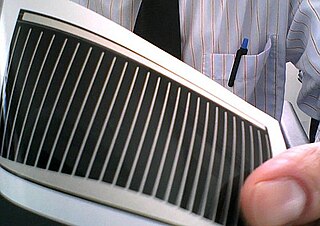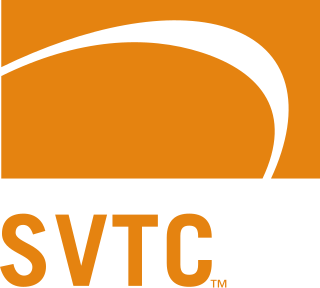
Photovoltaics (PV) is the conversion of light into electricity using semiconducting materials that exhibit the photovoltaic effect, a phenomenon studied in physics, photochemistry, and electrochemistry. The photovoltaic effect is commercially used for electricity generation and as photosensors.

The National Renewable Energy Laboratory (NREL) in the US specializes in the research and development of renewable energy, energy efficiency, energy systems integration, and sustainable transportation. NREL is a federally funded research and development center sponsored by the Department of Energy and operated by the Alliance for Sustainable Energy, a joint venture between MRIGlobal and Battelle. Located in Golden, Colorado, NREL is home to the National Center for Photovoltaics, the National Bioenergy Center, and the National Wind Technology Center.
Nanosolar was a developer of solar power technology. Based in San Jose, CA, Nanosolar developed and briefly commercialized a low-cost printable solar cell manufacturing process. The company started selling thin-film CIGS panels mid-December 2007, and planned to sell them at 99 cents per watt, much below the market at the time. However, prices for solar panels made of crystalline silicon declined significantly during the following years, reducing most of Nanosolar's cost advantage. By February 2013 Nanosolar had laid off 75% of its work force. Nanosolar began auctioning off its equipment in August 2013. Co-Founder of Nanosolar Martin Roscheisen stated on his personal blog that nanosolar "ultimately failed commercially." and that he would not enter this industry again because of slow-development cycle, complex production problems and the impact of cheap Chinese solar power production. Nanosolar ultimately produced less than 50 MW of solar power capacity despite having raised more than $400 million in investment.

Building-integrated photovoltaics (BIPV) are photovoltaic materials that are used to replace conventional building materials in parts of the building envelope such as the roof, skylights, or façades. They are increasingly being incorporated into the construction of new buildings as a principal or ancillary source of electrical power, although existing buildings may be retrofitted with similar technology. The advantage of integrated photovoltaics over more common non-integrated systems is that the initial cost can be offset by reducing the amount spent on building materials and labor that would normally be used to construct the part of the building that the BIPV modules replace. In addition, BIPV allows for more widespread solar adoption when the building's aesthetics matter and traditional rack-mounted solar panels would disrupt the intended look of the building.

First Solar, Inc. is an American manufacturer of solar panels, and a provider of utility-scale PV power plants and supporting services that include finance, construction, maintenance and end-of-life panel recycling. First Solar uses rigid thin-film modules for its solar panels, and produces CdTe panels using cadmium telluride (CdTe) as a semiconductor. The company was founded in 1990 by inventor Harold McMaster as Solar Cells, Inc. and the Florida Corporation in 1993 with JD Polk. In 1999 it was purchased by True North Partners, LLC, who rebranded it as First Solar, Inc.
MiaSolé is an American solar energy company selling copper indium gallium selenide (CIGS) thin-film photovoltaic products. MiaSolé's manufacturing process lays CIGS on a flexible stainless steel substrate. MiaSolé produces all layers of photovoltaic material in a continuous sputtering process.

Ascent Solar Technologies, Inc. is a publicly traded photovoltaic (PV) company located in Thornton, Colorado. Its primary product is a flexible CIGS solar cell on a plastic substrate.

Cadmium telluride (CdTe) photovoltaics is a photovoltaic (PV) technology based on the use of cadmium telluride in a thin semiconductor layer designed to absorb and convert sunlight into electricity. Cadmium telluride PV is the only thin film technology with lower costs than conventional solar cells made of crystalline silicon in multi-kilowatt systems.
Odersun was a German photovoltaic (PV) company that developed and manufactured CIGS cells on a flexible copper backing, specifically designed for building-integrated photovoltaics. The insolvent company went into administration on 1 June 2012 and filed for bankruptcy.

Thin-film solar cells are made by depositing one or more thin layers of photovoltaic material onto a substrate, such as glass, plastic or metal. Thin-film solar cells are typically a few nanometers (nm) to a few microns (µm) thick–much thinner than the wafers used in conventional crystalline silicon (c-Si) based solar cells, which can be up to 200 µm thick. Thin-film solar cells are commercially used in several technologies, including cadmium telluride (CdTe), copper indium gallium diselenide (CIGS), and amorphous thin-film silicon.

A copper indium gallium selenide solar cell is a thin-film solar cell used to convert sunlight into electric power. It is manufactured by depositing a thin layer of copper indium gallium selenide solid solution on glass or plastic backing, along with electrodes on the front and back to collect current. Because the material has a high absorption coefficient and strongly absorbs sunlight, a much thinner film is required than of other semiconductor materials.

Abound Solar was a manufacturer of cadmium telluride modules–a thin-film photovoltaic technology–based in the United States. It operated a production facility in Longmont, Colorado. The company was incorporated as AVA Solar in 2007 and was rebranded as Abound Solar in March 2009. In 2012 the company laid off almost half its employees before suspending operations and filing for bankruptcy.

SVTC Technologies was a technology services company that provided development and commercialization services for semiconductor process-based technologies and products. SVTC operated from 2004 to October 2012.
HelioSphera S.A. is a Greek company founded in 2007, with major stakeholders in Greece and the United States of America. Its headquarters is in Athens, Greece, and its production facility is in Tripoli, Greece. The company's primary product is photovoltaic solar panels and modules, made of micromorph thin-film with an annual capacity of 60MWp. The company has significant expertise in solar manufacturing.

Solar Frontier Kabushiki Kaisha is a Japanese photovoltaic company that develops and manufactures thin film solar cells using CIGS technology. It is a fully owned subsidiary of Showa Shell Sekiyu and located in Minato, Tokyo, Japan. The company was founded in 2006 as Showa Shell Solar, and renamed Solar Frontier in April 2010.
SoloPower Systems Inc. technology is used to create ultra-lightweight, thin-film, flexible Solar Panels, based on CIGS. Originally developed by San Jose, California-based Solopower Inc., the technology is now owned by Solopower Systems Inc., a solar panel development & manufacturing company based in Portland, Oregon. SoloPower technology features an electroplating process that utilizes nearly 100% of its materials to manufacture its CIGS cells.
Siva Power, Inc. is an American solar power company that developed thin-film technology. The company designed and manufactured copper indium gallium deselenide (CIGS) photovoltaics. Siva Power is based in San Jose, California. Bruce Sohn is CEO and Mark Heising is Chairman.
Flisom is a developer and manufacturer of photovoltaic (PV) thin film solar cells, located near Zurich, Switzerland. The company produces high-efficiency CIGS thin film solar modules on flexible plastic foil using proprietary roll-to-roll manufacturing techniques.









